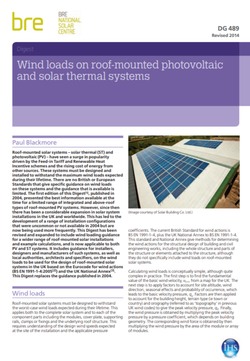Wind loads on roof-mounted photovoltaic and solar thermal systems DG 489
BRE (Building Research Establishment) is an independent, research-based consultancy, testing and training organisation, operating in the built environment and associated industries.
Wind loads on roof-mounted photovoltaic and solar thermal systems (DG 489) was written by Paul Blackmore and published by BRE on 22 May 2014.
Roof-mounted solar systems (both solar thermal (ST) and photovoltaic (PV)) have seen a surge in popularity driven by incentive schemes and the rising cost of energy from other sources. These systems must be designed and installed to withstand wind loads, but there are no British or European Standards that give specific guidance on wind loads on these systems and the guidance that is available is limited.
The first edition of this Digest, published in 2004, presented the best information available at the time for a limited range of integrated and above-roof types of roof-mounted PV systems. Since then there has been considerable expansion in solar systems, which has led to the development of a range of installation configurations that were uncommon or unavailable in 2004. As a result, the Digest has been revised and expanded to include guidance for a wider range installations and example calculations, and it is now applicable to both PV and ST systems.
It includes guidance for installers, designers and manufacturers, local authorities, architects and specifiers in the UK, based on the Eurocode for wind actions (BS EN 1991-1-4:2005) and the UK National Annex.
Its contents includes:
- Wind loads - determining the design wind load.
- Simplified method for determining peak velocity wind pressure, qpPressure coefficients.
- Designing free-standing solar systems on flat roofs to resist uplift, overturning and sliding.
- Fixing solar modules to the roof structure.
- Example calculations.
- References.
[edit] Related articles on Designing Buildings Wiki
- BRE articles on Designing Buildings Wiki.
- BRE Buzz articles on Designing Buildings Wiki.
- BRE National Solar Centre.
- BREEAM.
- Building Research Establishment.
- Five important factors to consider before installing solar panels.
- Large scale solar thermal energy.
- Renewable energy sources: how they work and what they deliver: Part 4: Solar thermal hot water systems DG 532 4.
- Solar photovoltaics.
- Solar thermal systems.
- Solar-assisted heat pump.
Featured articles and news
One of the most impressive Victorian architects. Book review.
RTPI leader to become new CIOB Chief Executive Officer
Dr Victoria Hills MRTPI, FICE to take over after Caroline Gumble’s departure.
Social and affordable housing, a long term plan for delivery
The “Delivering a Decade of Renewal for Social and Affordable Housing” strategy sets out future path.
A change to adoptive architecture
Effects of global weather warming on architectural detailing, material choice and human interaction.
The proposed publicly owned and backed subsidiary of Homes England, to facilitate new homes.
How big is the problem and what can we do to mitigate the effects?
Overheating guidance and tools for building designers
A number of cool guides to help with the heat.
The UK's Modern Industrial Strategy: A 10 year plan
Previous consultation criticism, current key elements and general support with some persisting reservations.
Building Safety Regulator reforms
New roles, new staff and a new fast track service pave the way for a single construction regulator.
Architectural Technologist CPDs and Communications
CIAT CPD… and how you can do it!
Cooling centres and cool spaces
Managing extreme heat in cities by directing the public to places for heat stress relief and water sources.
Winter gardens: A brief history and warm variations
Extending the season with glass in different forms and terms.
Restoring Great Yarmouth's Winter Gardens
Transforming one of the least sustainable constructions imaginable.
Construction Skills Mission Board launch sector drive
Newly formed government and industry collaboration set strategy for recruiting an additional 100,000 construction workers a year.
New Architects Code comes into effect in September 2025
ARB Architects Code of Conduct and Practice available with ongoing consultation regarding guidance.
Welsh Skills Body (Medr) launches ambitious plan
The new skills body brings together funding and regulation of tertiary education and research for the devolved nation.
Paul Gandy FCIOB announced as next CIOB President
Former Tilbury Douglas CEO takes helm.
























